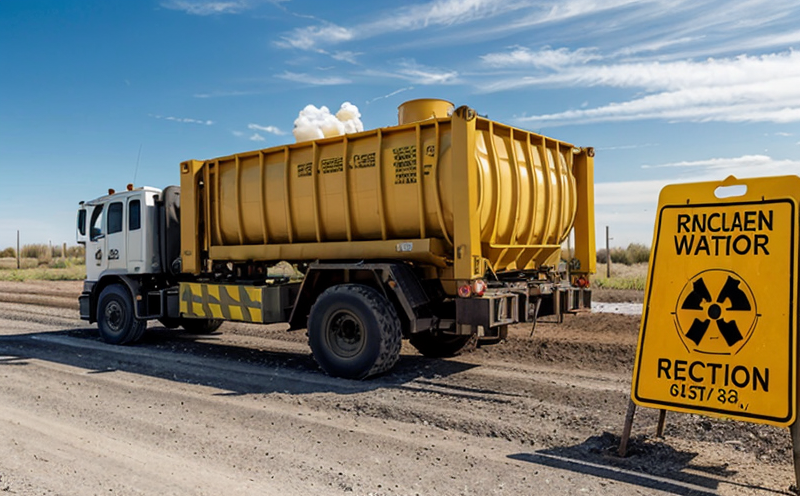ASTM C1625 Plutonium Isotopic Composition in Radioactive Waste
The ASTM C1625 standard provides a method to determine the isotopic composition of plutonium (Pu) in radioactive waste. This is an essential process for understanding the nature, behavior, and safety implications of spent nuclear fuel and other forms of radioactive materials. The test allows for accurate characterization of the Pu content by measuring its various isotopes—specifically 239Pu, 240Pu, 241Pu, and 242Pu.
The isotopic composition of plutonium is a critical factor in the safe handling, storage, and disposal of radioactive waste. It influences the potential for nuclear proliferation, the design of spent fuel reprocessing systems, and the environmental impact of long-term storage solutions. Accurate measurement of these isotopes ensures compliance with international standards and national regulations, thereby supporting sustainable practices.
The ASTM C1625 method is widely accepted in the nuclear industry due to its precision and reliability. It involves the preparation of a sample from radioactive waste, which must be handled under strict safety protocols to prevent contamination. The sample is then analyzed using a combination of chemical purification techniques followed by mass spectrometry.
The process begins with the dissolution of the Pu-containing material in nitric acid. This step ensures that all Pu isotopes are available for analysis. Subsequent steps involve the separation and enrichment of Pu isotopes, typically through ion exchange chromatography or liquid-liquid extraction methods. The purified Pu is then introduced into a high-resolution mass spectrometer, where its isotopic composition can be determined with sub-per-mill accuracy.
The results from ASTM C1625 are reported as ratios of the various isotopes relative to each other and to the total Pu content. These data are crucial for several applications in nuclear waste management:
- Assessing the potential risk of plutonium being used in weapons-grade materials.
- Guiding the design of fuel reprocessing plants.
- Evaluating the effectiveness of spent fuel storage and disposal strategies.
The precision of ASTM C1625 is paramount, as even small variations in isotopic ratios can have significant implications. For instance, a higher concentration of 240Pu may indicate a greater potential for spontaneous fission, which could lead to increased radiation levels if not properly managed.
The ASTM C1625 method is part of the broader regulatory framework that ensures nuclear safety and environmental protection. Compliance with these standards is essential for entities involved in the generation, handling, and disposal of radioactive waste. By adhering to this protocol, laboratories can provide accurate, reliable data that contribute to the safe management of nuclear materials.
The method is not only important for the nuclear industry but also has implications for environmental science and public health. Accurate isotopic composition analysis helps in understanding the long-term behavior of Pu-containing waste in various environments, which is critical for developing effective containment strategies.
Industry Applications
The ASTM C1625 method finds extensive application across multiple sectors within radioactive and nuclear waste management:
- Nuclear Power Plants: Used to monitor spent fuel reprocessing and verify the isotopic composition of Pu in reactor cores.
- Defense Industries: Essential for assessing the potential proliferation risk associated with Pu-containing materials from decommissioned weapons.
- Environmental Agencies: Help in establishing baseline data for long-term environmental impact assessments related to nuclear waste disposal sites.
The precision and reliability of ASTM C1625 make it a cornerstone of international efforts to ensure the safe management of radioactive materials. Its application extends beyond mere compliance; it plays a vital role in safeguarding public health and the environment by providing accurate isotopic data for decision-making processes.
For quality managers, compliance officers, R&D engineers, and procurement professionals involved in nuclear waste management, understanding and applying ASTM C1625 is crucial. By leveraging this standardized method, these stakeholders can ensure that their operations meet stringent safety standards and regulatory requirements.
International Acceptance and Recognition
- The ASTM C1625 standard is widely recognized by international bodies such as the International Atomic Energy Agency (IAEA).
- American Nuclear Society (ANS) and European Organization for Nuclear Research (CERN) also recommend this method.
- It is included in national standards like ISO 34001, which emphasizes the importance of safety and environmental management systems.
The international consensus on ASTM C1625 underscores its significance in the global nuclear industry. Laboratories accredited to perform this test are trusted by governments, regulatory bodies, and private entities worldwide. The standard ensures that results from one laboratory can be validated against another, fostering a collaborative approach to nuclear waste management.
Use Cases and Application Examples
The ASTM C1625 method is integral in several critical applications within radioactive waste management:
- Nuclear Fuel Reprocessing: Ensures the safe extraction of Pu from spent fuel rods.
- Waste Characterization: Provides detailed data on the isotopic composition to assess potential hazards and risks.
- Disposal Site Monitoring: Helps in evaluating the long-term stability and integrity of waste repositories.
In practice, ASTM C1625 is used to analyze samples taken from various stages of nuclear fuel cycles. For example, during reprocessing, the method helps in identifying and separating different isotopes of Pu for further processing or disposal. In waste characterization, it assists in determining the exact composition of spent fuel, enabling more precise risk assessments.
The method is also crucial for monitoring the integrity of deep geological repositories where high-level radioactive waste is stored. By regularly analyzing the isotopic composition, researchers can detect any changes that might indicate potential leaks or other issues. This proactive approach ensures that waste management practices are continuously optimized to minimize environmental and public health risks.





